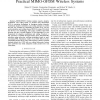Free Online Productivity Tools
i2Speak
i2Symbol
i2OCR
iTex2Img
iWeb2Print
iWeb2Shot
i2Type
iPdf2Split
iPdf2Merge
i2Bopomofo
i2Arabic
i2Style
i2Image
i2PDF
iLatex2Rtf
Sci2ools
GLOBECOM
2008
IEEE
2008
IEEE
A Supervised Learning Approach to Adaptation in Practical MIMO-OFDM Wireless Systems
—MIMO-OFDM wireless systems require adaptive modulation and coding based on channel state information (CSI) to maximize throughput in changing wireless channels. Traditional adaptive modulation and coding attempts to predict the best rate available by estimating the packet error rate for each modulation and coding scheme (MCS) by using CSI, which has shown to be challenging. This paper considers supervised learning with the k-nearest neighbor (k-NN) algorithm as a new framework for adaptive modulation and coding. Practical kNN operation is enabled through feature space dimensionality reduction using subcarrier ordering techniques based on postprocessing SNR. Simulation results of an IEEE 802.11n draftcompatible physical layer in flat and frequency selective wireless channels shows the k-NN with an ordered subcarrier feature space performs near ideal adaptation under packet error rate constraints.
Adaptive Modulation | GLOBECOM 2008 | Packet Error Rate | Telecommunications | Traditional Adaptive Modulation |
| Added | 29 May 2010 |
| Updated | 29 May 2010 |
| Type | Conference |
| Year | 2008 |
| Where | GLOBECOM |
| Authors | Robert C. Daniels, Constantine Caramanis, Robert W. Heath Jr. |
Comments (0)

